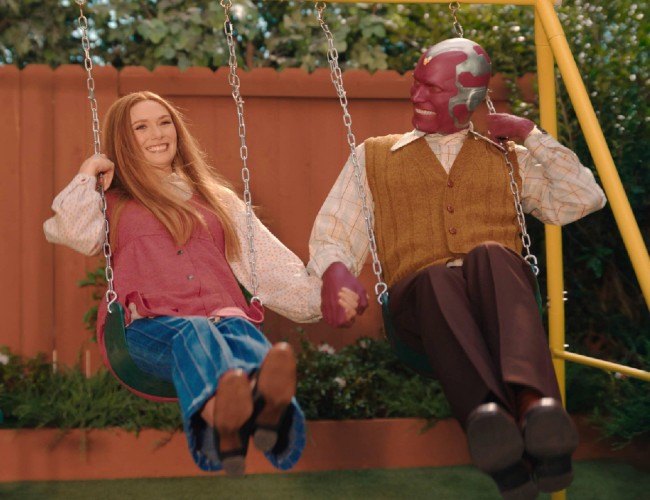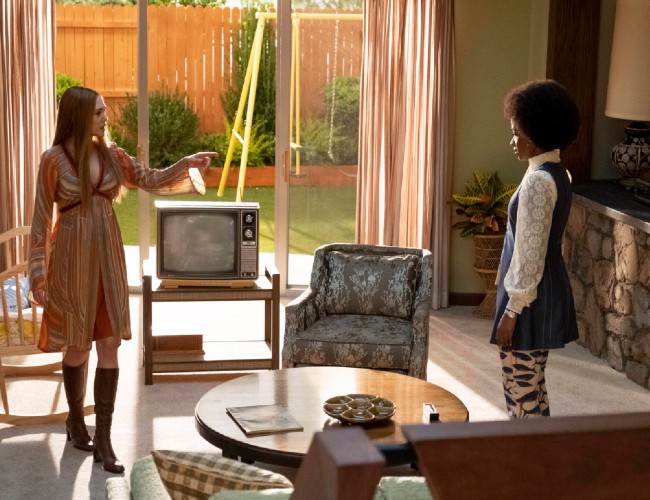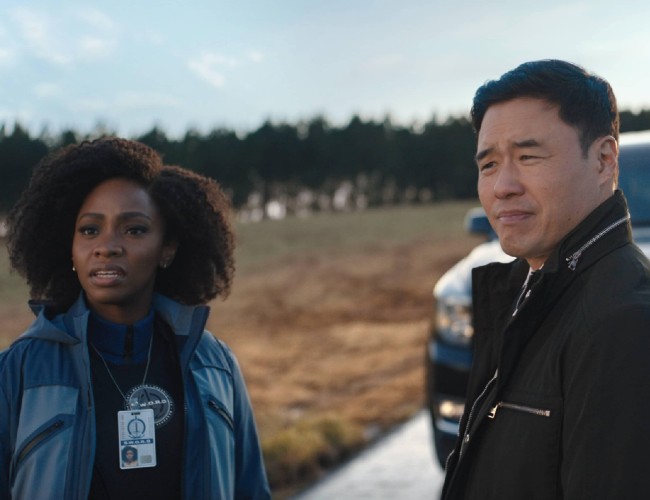SPOILERS AHEAD … AND THE DISTORTED REALITY OF GRIEF …
Even in the first two classic sitcom-styled episodes of WandaVision, one of the best shows to hit any screen in quite some time, it became patently obvious that all was not well in the suburban idyllic world of Westview, New Jersey.
For every wry grin to camera or corny visual flourish, for all the warmth and love between Vision (Paul Bettany) and Wanda (Elizabeth Olsen), there were clear signs that a great deal of trauma was behind the black-and-white sunny facades.
That moment at the pool where Wanda and Dottie Jones (Emma Caulfield Ford) hear disembodied voices coming from a speaker or the dinner with Vision’s boss that just got stranger and more alarming as it went on and even to the colour retro tin helicopter landing in the black-and-white hedge outside Wanda and Vision’s and the beekeeper appearing in the street (a symbol of Hydra), it becomes crystal clear that whatever is going on in this cartoon-perfect world, it is based on something so dark and diabolical that no one dares speak its name.
Wanda, most of all.
For in a brilliant act of revelatory storytelling, courtesy of one of the townspeople, Geraldine (aka Monica Rambeau played by Teyonnah Paris) being flung out of a crackling portal of light into the real world, we found out that Westview is a fictional construct made possible by a prodigious act of reality warping courtesy of Wanda who has made an entire world for herself in which Vision lives and they are blissfully happy.
It is all a grief-fuelled lie, of course, since as we know, Vision died in of 2018’s Avengers: Infinity War courtesy of Thanos and his diabolical quest for the complete set of the Infinity Stones, and in a rare act of staying true to the reality they have crafted, he remains very much dead, even as many other people, half the universe’s population in fact, came back from oblivion (they disappeared in an event known as The Snap) when Thanos was defeated.
Among those people, known as the Dusted, is Monica Rambeau who returns to S.W.O.R.D. (Sentient Weapon Observation and Response Division), a counter terrorism unit dedicated to facing off against extraterrestrial threats, caught in her own post-Snap trauma as she faces the loss of her mother to cancer in the five years she was away, and immediately sent off to find out what the hell is going on at Westview.
Episode 4, “We Interrupt This Program”, is where the metaphorical curtain is pulled away by Toto to reveal the Wizard; only rather diminishing the magic of WandaVision thus far, it serves to deepen and illuminate it in ways that leave you gasping.
For now we know, that all the Bewitched/Dick Van Dyke Show/Brady Bunch fun of Wanda and Vision’s cosy suburban idyll, is nothing but a shimmering oasis of patent, if reassuring, falsehoods.
Powered, it appears, by Wanda, Westview is the ultimate construct of grief, the result of trauma left unchecked and untreated, its power, strength and expansiveness, seemingly shocking even to Wanda who banishes Geraldine aka Monica from Westview – it appears that everyone in the town is being held there against their will, unable to leave as the doctor remarks at one point when he mutters that you can’t leave a small town and indicated again when Vision catches his neighbours, Agnes (Kathryn Hahn) and Herb (David Payton agitatedly gossiping by the fence before they resume their sunny dispositions – staring after her with something bordering on confusion.
Of course, at this stage, nothing is confirmed and everything is possible; what we can say for certain is that we are not in sitcom-happy Kansas anymore and likely never were.
Once happy part of all this revelatory going on is that we get to see the return of FBI agent Jimmy Woo (Randall Park) and astrophysicist Darcy Lewis (Kat Dennings), who appeared first in Ant-Man and the Wasp and Thor: The Dark World respectively, who join forces to try and figure out what is going on inside the shimmery forcefield guarding Westview.
It is actually Darcy who discovers that there’s a broadcast signal embedded in cosmic microwave background radiation, and that that broadcast signal is taking the form of decades’ worth of classic sitcoms.
By watching the show, and identifying the people playing the characters, they are able to determine that Wanda is seemingly behind it all, whatever “it” is exactly and that it might be possible to talk to her (or at her, at least) by broadcasting into the town.
It is utterly absorbing and fascinating stuff.
If WandaVision wasn’t already intriguing enough, with dark fingers of discomforting reality constantly trying to reach into its happy perfection, its sitcom sheen broken by dramatic horror-filled moments which Wanda quickly banishes before Vision can be made aware of them, it is now doubly so we episode four takes us outside the grief-powered construct to see what everyone else is seeing looking in.
Keep in mind that post-Snap the world is soaked to an overwhelming degree in spirit-sapping loss, pain and grief, and while people like Monica do their best to solider on and pretend they are okay, Wanda is clearly manifesting all her grief into a world in which the trigger point of her profound loss never happened.
Or she can pretend it never happened, anyway.
It is the first time, from this reviewer’s recollection at least, that anyone has truly delved deep into the trauma involved in keeping the world safe, or trying to, at least, from great, cataclysmic evil, and to see it tackled in such an inventive, imaginative but entirely thoughtful and nuanced way is a revelation in and of itself.
These layers upon and within layers, those prettied up with The Brady Bunch zest and laughs, and a willingness to suspend reality – within one episode, Wanda falls pregnant and gives birth to twins (Tommy and Billy, the kids who first appear in comic The House of M), with everyone in the town pretty much going along with it; if we take the idea of them all as captives, that makes perfect, if twisted, sense – mask a world, nay universe of hurt on Wanda’s part, and since she has the power to generate anything she wants, Westview is how it forms itself into something she can handle.
But it’s not sustainable, running from profound and soul-destroying grief never, ever is, and it looks WandaVision is going to make the most of its unusual premise, it’s exuberantly rich execution and its willingness to switch between sitcom light and real life dark.
Quite where it all leads is anyone’s guess, but safe to say with just five episodes remaining in this current run – episode 9 airs on 5 March – and an immense amount of lore and broken humanity to explore, WandaVisionm which has already proven it is an extraordinary piece of storytelling, will no doubt take us to some blindly good and sorrowfully great places yet, all wrapped in the candy-coated wonder of classic TV.


